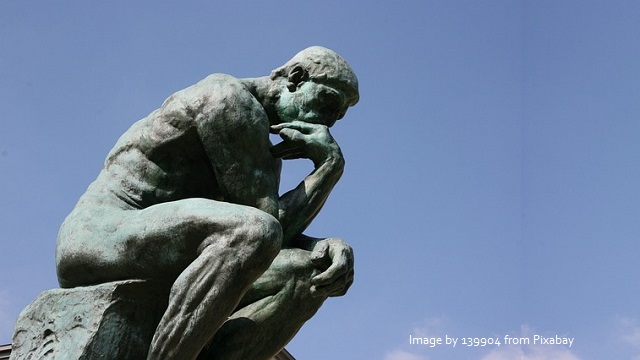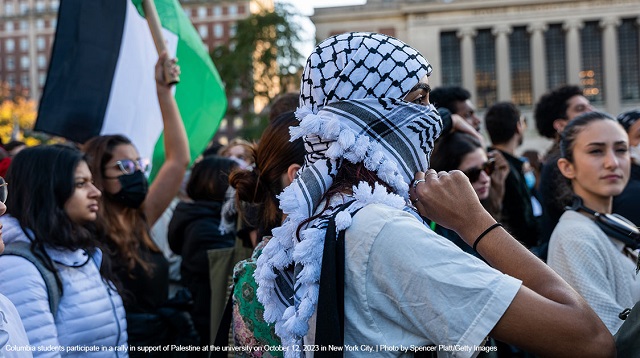Florida Earns Top Spot on Education Freedom Report Card (Arizona is #2)
By Samantha Aschieris
Editors’ Note: Those who want the hear the podcast can scroll to the to the eleventh one below. Those who prefer to read the transcript can continue below.
Florida has once again been ranked No. 1 among the states on The Heritage Foundation’s Education Freedom Report Card, which was released at an event Thursday in Des Moines, Iowa.
“They have universal education choice in that state. Any child who wants it can exercise school choice,” says Lindsey Burke, director of The Heritage Foundation’s Center for Education Policy. (The Daily Signal is the news outlet of The Heritage Foundation.)
“You’ll notice I say ‘education choice’ more often than ‘school choice,’ because we’re at a point now in the movement where states are adopting education savings accounts largely, although it’s great if a state adopts a voucher or a tax credit, but these education savings accounts, ESAs, are much more flexible,” Burke says, adding:
So, Florida took [its] education savings account program universal so every child now can exercise education choice. [It has] radical academic transparency to families. Families know what is taught in their public schools.
There’s some movement on teacher freedom to make it easier for professionals to enter the classroom without having to go through woke colleges of education in order to get there.
Burke also notes that Arizona was once again in the No. 2 spot, and Utah clinched the No. 3 spot.
“Arizona is actually first in the country for education choice, but overall came in second on the report card. And then rounding out our top three was Utah,” Burke says. “Utah, also, this year adopted a universal ESA style account, where pretty soon every single child will be able to exercise education choice.”
Iowa, which hosted the event at which the report card was released, was ranked “most improved.”
Burke joins today’s episode of “The Daily Signal Podcast” to further discuss the Education Freedom Report Card, which three states ranked the lowest, and her advice to parents who might see the report card and want to make a change in their state.
Listen to the podcast below or read the lightly edited transcript:
Samantha Aschieris: Lindsey Burke is joining today’s episode of “The Daily Signal Podcast.” Lindsey is the director of The Heritage Foundation’s Center for Education Policy. Lindsey, thanks so much for joining us today.
Lindsey Burke: Thanks for having me, Samantha.
Aschieris: Now, on Thursday, The Heritage Foundation held an event in Des Moines, Iowa, on its second Education Freedom Report Card. Before we talk more about the report card, though, and this year’s results, can you tell us what exactly the report card is?
Burke: Yeah, so, this report card is unique for a few reasons. I think the name in and of itself gives you an idea of why it’s unique. This is the Education Freedom Report Card. It is not just your old standard ranking of how much states spend and where students stand.
Usually, when you see these report cards, that’s what they measure. How many dollars are states spending, how much are they relying on taxpayers, and then, where do students stand academically? Well, ours goes much deeper than that, and in fact, is unique because we actually look at ROI, return on investment, how much does a state spend, but how much does every dollar get you in terms of your academic improvement?
So, it’s not inputs-based, it’s actually outcomes-based, which is unique in that regard. But what is, I think,, the most important aspect of this report card is, we look at genuine education freedom.
How much of an opportunity does a family have to exercise school choice, or education choice to craft an education experience that fits the unique needs and aspirations of their individual child? That is one of the most important factors that we measure in this report card, but it is comprehensive in nature in that we look at education choice, but we also look, like I said, at return on investment.
We look at teacher freedom: How easy is it for a professional who decides they want to teach to actually enter the classroom, or does a state put up barriers to entry, like these what we know empirically to be useless teacher-certification requirements?
And then we look at transparency, which has become such an important factor in recent years. In particular, parents really acknowledging waking up to the fact that the content that has been taught in public schools across the country for too many years now does not reflect their family’s values, their community’s values, and unfortunately, too often has been wholly captured by the Left.
So, we look at transparency. How much transparency does a parent have into the content that’s taught in their local schools? How much leverage do they have over something like their school board? Is their school board election on cycle—which is a really important measure of how much input and control a community has in shaping their local public schools.
So again, it’s comprehensive. It goes much further, I think, than any other education ranking certainly that’s out there. But, really importantly, I think, [it] looks at your return on investment as a taxpayer, your return on investment as a parent, and your ability to actually exercise choice for your child, which is the No. 1 accountability measure that a family has.
Aschieris: Absolutely. And for our listeners, we’ll be sure to leave a link to this year’s report card in the show notes, so they can take a look at where their state stands. Before we get into this year’s results, though, I wanted to just take a step back and ask why was it important for The Heritage Foundation to create this Education Freedom Report Card?
Burke: Yeah. Well, education is one of the most important public policy issues that is, I think, has really risen to the top of public consciousness today. You look around the country. There are so many issues afflicting all American families. So many of those issues, though, are tied back to education.
If you are worried about a public school that your child is assigned to, for instance, calling your child by a name other than the name that you as a parent gave them when they were born, education is a policy issue that is important to you. If you are worried about critical theory or critical race theory, or any sort of radical, critical theory offshoots that are out there, be it gender ideology or radical feminism, fill in the blank, critical theory writ large.
If you are worried about these issues, education policy should be a front-and-center issue of concern for you, an area of involvement for you.
If you’re just worried about sort of your, for lack of a better word, standard academic performance of your child’s public school, you’re going to be concerned about ed policy. If you’re worried about students’ safety, we’ve interviewed families for years and years, and I’m sitting here in Washington, D.C., where this is a paramount concern, but so many families, that is their No. 1 issue.
First and foremost, when I send my child to school for seven or eight hours a day, are they going to be safe? If schools can’t answer that basic question to the satisfaction of a family, nothing else matters. And so, if safety is an issue for you, you’re going to care deeply about education policy.
I think at the end of the day, though, where we are right now is education policy is a vehicle for values alignment, which is where school choice comes in, a way that it really hasn’t before. It’s almost cliche at this point to say it, but COVID school shutdowns, and they weren’t COVID school shutdowns, right? They were teachers union-induced school shutdowns, where COVID was sort of the ruse long after we knew it was safe to reopen schools. But these teachers union-induced school shutdowns had at least the positive effect of opening the eyes of a lot of families to this content that was taught in their children’s schools.
When they all became accidental homeschoolers looking at the curriculum, and the lessons that were being taught virtually to their children, that became such an issue for families where they were able to see firsthand that there was a misalignment too often in the values that their families held dear and what was being taught to their children for those eight hours during the day.
And so, what I think has happened over the past two years or so is that we had a wonderful and have a wonderful school choice movement, where the focus had largely been improving academic outcomes for kids who were participating in programs and students who chose to stay in the public system.
We also had a really strong focus on the economic imperative of choice, where if you want to see a better [return on investment], school choice is an answer for you, but in a lot of ways, that values-based case for school choice was absent from the conversation until a few years ago.
And COVID really shifted that narrative. All of a sudden, it became for families who were seeing too often radical content taught in schools, “Hey, there’s a solution. It’s called school choice. School choice is an answer for you as well.” And so, all of that to say, the report card is unique in that it captures all of these factors that are really motivating families right now.
And motivating, I would say not just families, but all Americans, right? All American taxpayers, American grandparents in addition to parents, anybody who is living in this country right now is touched by education policy. And I think the past few years have demonstrated that in a really profound way.
Aschieris: Absolutely. And now just to shift into this year’s results for the report card, which states were in the top three, and why?
Burke: Yes. Well, our top three, drumroll, do you have some sort of electric drumroll we can play?
But our No. 1 state, which was also our No. 1 state last year was the state of Florida. Florida came in No. 1. They have universal education choice in that state. Any child who wants it can exercise school choice. You’ll notice I say “education choice” more often than “school choice,” because we’re at a point now in the movement where states are adopting education savings accounts largely, although it’s great if a state adopts a voucher or a tax credit, but these education savings accounts, ESAs, are much more flexible.
So, Florida took [its] education savings account program universal. So every child now can exercise education choice. [Florida has] radical academic transparency to families. Families know what is taught in their public schools. There’s some movement on teacher freedom to make it easier for professionals to enter the classroom without having to go through woke colleges of education in order to get there.
So, Florida retained [its] No. 1 ranking this year. Arizona came in second place. Arizona retained its No. 2 ranking. Arizona is actually first in the country for education choice, but overall came in second on the report card. And then rounding out our top three was Utah. Utah, also, this year adopted a universal ESA-style account, where pretty soon every single child will be able to exercise education choice.
And this is what has been, I mean, it’s an exciting time for ed policy. I tell people all day long, I don’t know why people aren’t on the rooftop shouting about how amazing it is that we’re at a point now where nine states now have universal education choice on the books. This is unbelievable.
That number was zero two years ago, and all of a sudden now, we have nine states with universal school choice. It is unbelievable. It’s such a welcome development for families. And I think pretty soon we’re going to be at a tipping point. We’re all eagerly awaiting Texas to see if anything comes out of Texas with regard to school choice this session.
But pretty soon we’re inching toward 40% of kids across the country now having access or at least being eligible for a private school choice program. So exciting to see. But those are our top three, Florida, Arizona, Utah.
Aschieris: And then what about the bottom three? Who are those states?
Burke: Right. And this is interesting, and I think demonstrates what makes our report card different from a lot of report cards you would see from say, education associations or more establishments, education organizations, because some of these states will often end up being at the top and on our report card, they’re on the bottom, and that is Rhode Island, Connecticut, and at the very bottom, No. 51, because we count [Washington, D.C.], but Oregon.
Oregon’s at the very bottom. And that is largely due to extremely poor, completely absent for that matter, education choice. Families are assigned to their local government-run district school, whether they like it or not, whether or not it’s safe, whether or not it works well for their child, whether or not it aligns with their values, that’s your public school, that’s where you attend. So, no education choice.
Transparency, they rank really poorly on transparency as well. It is nearly impossible for parents to see what is being taught in schools in Oregon. And in fact, now breaking over the past week or so, we’re seeing Oregon make this push for so-called equitable math, which is what it sounds like. Not traditional math instruction that we all came to know, but really just left-leaning, woke sort of nonsense, dressed up as math instruction.
Oregon also did really poorly on teacher freedom. You have to jump through a lot of hoops in order to become a teacher. Hoops that don’t matter in the long run. I should add for our listeners that we know empirically, there is no association between someone having a state teacher certification, state licensure, and their ability to be an effective teacher as measured by how much they’re able to get students to learn. We know there’s no correlation between teacher certification and student academic achievement.
And then, finally, on return on investment, Oregon did terribly on that measure as well, 39th overall. They’re spending a lot of money per pupil in Oregon. And student outcomes are middling, to say the least. So, much of the same story for our Nos. 49 and 50, for Rhode Island and Connecticut. Little to no education choice, lack of transparency, lack of teacher freedom, and poor return on investment.
Aschieris: Now, in terms of the state that improved the most, Iowa, what improvements did they make to earn them that ranking of “most improved”?
Burke: Yeah, so, Iowa really had just wonderful improvement over our initial, last year was our inaugural, the 2022 report card. This is our second year, as you mentioned. So, from 2022 to 2023, Iowa jumped 13 spots in the ranking, which was just a massive improvement.
And that is largely a reflection of the fact that [Gov. Kim] Reynolds’ leadership, Senate President Amy Sinclair’s leadership, they were able to get a universal ESA-style program in place.
So, in the course of the next three years, every single child in Iowa, if they want it, will be able to access an ESA-style account. So, instead of being assigned to their public school, can instead exercise choice and attend any private school that fits their needs or create a customized education experience for themselves.
They can hire private tutors, do online learning, whatever it is that fits their unique learning needs. So, that was really the No. 1 reason.
And Iowa was actually first out of the gate this year in 2023 at getting a universal school choice program in place. I mentioned earlier that we now have nine states with universal education choice. Two of those happened in 2022, seven happened this year. I mean, this is why I’m saying 2023 has been a phenomenal year for education freedom.
Seven states just this year got universal school choice in place. So, Iowa led out of the gate this year. They were the first state to get it done this year. And then we had six other states follow, and I would add, importantly, that they didn’t stop with education choice.
They also put in strong transparency protections for families. They put in provisions that prevent teaching on sexual orientation and gender identity until it is age-appropriate. Similar to what we saw in Florida in recent years, school libraries have to put their card catalogs online so parents can see what school libraries are carrying there.
And then there is also a provision as part of their parental bill of rights that looks similar to something known as a Given Name Act. So, with the Given Name Act, which we’ve seen several states adopt, a school is prohibited from changing a child’s name or pronoun, absent written parental consent. So, they didn’t get quite that far, but they made a really good step in the right direction, which is to say, if a child is trying to change their name at school during the school day, the school has to notify parents. So, they put that provision in there as well. So, they did a, whole just sort of, basket of reforms, but chief among them was that universal education choice policy that’s now in place.
Aschieris: And in addition to Iowa, Arkansas also made some major gains moving up to No. 4 from No. 13. So, what happened there?
Burke: Yeah, again, fantastic leadership, [Gov. Sarah Huckabee] Sanders there. We saw a similar move with a universal ESA account put into place in Arkansas. And I should say, I mean, we don’t have to delve into the boring methodology. I mean, I think it’s exciting, but all the methodology behind the report card rankings.
So, states are obviously awarded on the extent of their school choice landscape, and we do that in a number of ways. We look at the proportion of students who are eligible, the proportion of kids actually utilizing the accounts, but we also look at things like, is it an ESA versus a voucher?
Again, we love a good school voucher. However, ESAs … at this point, do everything a voucher does and then provide additional flexibility for a family. Like I mentioned, you can also hire a private tutor, buy textbooks, curriculum online learning in addition to paying that private school tuition.
And so we do award bonus points for ESAs over, I guess we could now call it, traditional school choice mechanisms. We also look at how regulated or overregulated a particular school choice program is in a state.
One thing the research community has long been interested in, to put it nicely, is an unfortunate occurrence in Louisiana, where in the state of Louisiana, we have the only negative evaluations of a school choice program in the history of school choice programs.
And so, this was a randomized control trial evaluation that found that students who exercised choice in the Louisiana voucher program did worse than students who did not. And it was [the randomized control trial] equivalent to a double-blind medical trial. So, rigorous evaluation. But what the research suggests is that the reason that that happened was because in the name, ironically, of accountability, they overregulated their voucher program so much that high-quality private schools said it wasn’t worth it to them to participate.
They set it out. We think lower-quality private schools ended up participating more than the high-quality private schools, and therefore, we think that explains why we got negative outcomes in Louisiana.
Again, unique to every state with a school choice program. Long way of saying that is why it’s important that as part of our school choice measure, we look at if a school choice program is overregulated. We’re seeing so much education choice in the states now. It is wonderful, but we can now be, I think as a movement, a little pickier about how we evaluate these programs.
Are they free from overburdensome regulations? How well is implementation going with these programs? That’s something that I think observers are really going to have to pay attention to, moving forward. Are these programs being implemented with fidelity in a way that they’re going to serve the most families the best they can for the long-term?
And then making sure that we actually talk to families in the states that these programs are out there, that they now have the choice to go to a private school if they want. And so, making sure that we educate families on their options and get those enrollment numbers up.
So, yes, again, long explanation to your question about Arkansas, but Arkansas has done phenomenal as well. We saw them shoot up to fourth place this year, which was great.
Aschieris: Lindsey, just before we go, I wanted to ask if you had any advice to parents who might see this report card and want to make a change in their state, what would you tell them?
Burke: Well, that is our hope, is that families and legislators see this report card and maybe they get a little angry about where their state ranks, if they’re toward the bottom and why their state doesn’t offer education freedom or why, for example, the proportion of their unfunded teacher-pension liabilities is a huge percentage of their state [gross domestic product]. Maybe that will make them mad, right?
We want this to animate families and policymakers in such a way that they do go to their school boards or they talk to their policymakers in their state and try to see improvements. And so, in order for them to do that, we’ve actually developed model policy that’s on the report card website.
So, if you’re in a state, for instance, that does not have a school choice program or doesn’t have a universal program or an ESA option, we have model legislation linked on the website for a universal ESA. We have model bills for almost everything that we measure on this report card. And so that’s kind of the idea, right?
People want to see their rankings improve. Policymakers, governors want to see their states move up in the ranking, and it is plug-and-play. Here’s some model policies that can help you, hopefully, achieve that goal.
Aschieris: Well, great. Lindsey, thank you so much for joining us today. It was great to have you on. As I mentioned, we’ll leave a link to the report card in the show notes. And yeah, thank you so much.
Burke: Thanks for having me.
*****
This article was published by Daily Signal and is reproduced with permission.
TAKE ACTION
As we move through 2023 and into the next election cycle, The Prickly Pear will resume Take Action recommendations and information.










